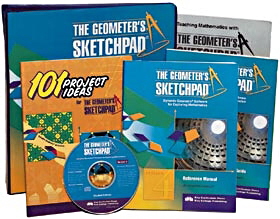

Practice making five or six circles of different sizes. Press and hold the mouse button while moving the mouse.Ī circle should appear. To draw a circle, move the mouse to the right

The Circle Tool: Select the circle tool by using the mouse to position the arrow over theĬircle tool and click once. To the right of the tools is called the window. The five mostĬommonly used tools and their names are at the top of this page. The left on the sketch you will see six different squares with different Now you are looking at the basic GSP layout, called a sketch. Much as possible during these, and all the subsequent, exercises.Īs GSP starts up, you will see a picture with the words "The Geometer's These are theīasic elements for creating Sketchpad sketches. Perpendicular lines, parallel lines, and angle bisectors. Use some of the built-in constructions, particularly mid-points,
Geometer sketchpad lessons how to#
Select one or more objects that have already been drawn and how to Presented here provides a brief introduction to Sketchpad. Lesson 1: Introduction to Geometer's SketchPadįor these exercises and investigations you will need to be able to use theīasic features of Sketchpad. Gifted students can be provided assignments that require more complex use of the software.Dynamic Geometry Workshop: Sketchpad Basics Students with Learning Disabilities will be provided the accommodations required to provide them with access to the computer. Students will be asked to duplicate the project and produce a drawing similar to the one shown attachedĪdaptations (For Students With Learning Disabilities): Using Geometer's Sketchpad provides the student with another tool to help understand Geometry concepts of all kinds
Geometer sketchpad lessons software#
The students will be able to use the software at their next computer lab session to explore the construction method and the results The resulting construction is show on the attached page. Observe that the sum of the two angles and the measurement of the outside angle remain the same even though the individual angles change. Use the arrow to move any vertex of the triangleĪ. The total angle will be displayed and will be the same as the exterior angle.ġ7. Select the first opposite angle in the upper left hand side of the windowĬ. The outside angle measurement is displayedġ6.Ĝalculate the outside angle from the sum of the two remote angles.ī. Select two points on the triangle adjacent to the point and then the pointī. If necessary, move the point outside the triangleġ4. Select Construct then Point on the LineĬ.

Select two points on an edge of the triangle and construct a line.ġ3.Ĝreate a point on the line outside the triangle.ī. Use the translation arrow tool to move any vertex and observe that the individual angles change but the total remains at 180°.ġ2. The total of the three angles will be displayed - 180°ġ1. Select all three angles in order with the + sign in betweenġ0. Select each angle measurement and then the + sign in the Calculator objectĪ. Repeat the process for the other two anglesĩ. GSP will measure the angle ABC and display in the upper left cornerħ.

Start at the top vertex of the triangle and select each of the three vertices in counterclockwise order.ī. Open Geometer's Sketchpad software by clicking on icon.ģ.Ĝreate a triangle by dragging three points around to form the triangle.ĥ. Procedure for calculating the sum of the inside angles of a triangle using Geometer's Sketchpadġ. The students will already have had a tutorial on the use of the software This will aid their ability to visualize the problem as the first step in proposing a proof.Ĭomputer with Geometer's Sketchpad software installed The students will be able to demonstrate how to calculate the sum of the inside angles and manipulate the shape to demonstrate that the total will not change. Using Geometer's Sketchpad, a virtual manipulative program that can be used for the teaching of Geometry the students will demonstrate that the sum of the inside angles of a triangle will always be 180° while the triangle changes shape and that the exterior angle will always remain the sum of the two remote interior angles. Michigan High School Mathematics Content Expectations Strand 3:Geometry and Trigonometry - Standard G1.2.1 Prove that the angle sum of a triangle is 180° and that an exterior angle of a triangle is the sum of the two remote interior angles. Lesson Plan Title: Using Geometer's Sketchpad to study trianglesĬoncept / Topic To Teach: Geometry/Sum of angles of a triangle equal 180° Materials Required: Computer with Geometer's Sketchpad installed Posted Mon Nov 1 19:50: by Richard Lasky ( Richard Lasky). Using Geometer's Sketchpad for Triangle study Mathematics, level: Senior


 0 kommentar(er)
0 kommentar(er)
